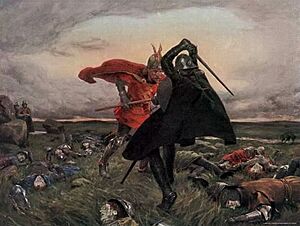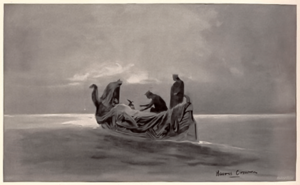Battle of Camlann facts for kids
The Battle of Camlann (Welsh: Gwaith Camlan or Brwydr Camlan) is a famous legendary battle. It is known as the final fight of King Arthur. In this battle, Arthur was either killed or badly hurt. He fought against or alongside Mordred, who also died.
The first stories about Camlann are very old. They come from Welsh texts around the 10th century. These early stories are not very detailed. Later, in the 12th century, more detailed versions appeared. These were often based on a book called Historia Regum Britanniae. Even more exciting versions came from French stories called chivalric romances. In these, the battle was sometimes called the Battle of Salisbury. A popular version today is from the 15th-century book Le Morte d'Arthur.
Contents
What Does the Name "Camlann" Mean?
The name "Camlann" might come from an old British language. It could mean "crooked enclosure" or "twisting open land." Another idea, though less likely, is "crooked bank of a river." There was a Roman fort called Camboglanna in Cumbria, which has a similar name.
Was the Battle Real?
The oldest mention of the battle is in a Welsh record from the 10th century. It says that in the year 537, there was "strife of Camlann." It also says that "Arthur and Medraut fell," and many people died in Britain and Ireland. This is the first time Medraut (who later became known as Mordred) is mentioned. But the record does not say if Arthur and Medraut fought together or against each other. It also does not say who won.
Some experts, like Andrew Breeze, think the battle was real. He believes it happened after a terrible famine in 535–536. This famine caused many deaths, as the old records say. Breeze thinks Camlann was a fight over cattle in central Britain. He suggests it might have been at Camboglanna (Castlesteads) near Carlisle. He believes Arthur was killed there by people from the kingdom of Rheged.
However, most historians think Arthur and the Battle of Camlann are just legends. Nick Higham points out that Camlann is not in an earlier list of Arthur's battles. He thinks the story might have come from a sad poem about a different Arthur.
Famous Stories About Camlann
Early Welsh Stories
One of the first mentions of Camlann is in a poem from the 9th or 10th century. It talks about a grave at Camlann. An 11th or 12th-century Welsh story, Culhwch and Olwen, mentions the battle twice. It names three men who survived Camlann:
- Morfran ail Tegid because he was very ugly.
- Sandde Bryd Angel because he was angelically beautiful.
- Cynwyl Sant because he was the last to leave Arthur.
This shows that Camlann was known as a battle where very few people survived.
Old Welsh writings called the Welsh Triads give clues about why the battle happened. One Triad says that Medrawd (Mordred) took over Arthur's throne while Arthur was away fighting. This started the battle. Another Triad says that a fight between Arthur's wife Gwenhwyfar (Guinevere) and her sister Gwenhwyvach caused the "Strife of Camlann." This fight was called one of Britain's "Three Harmful Blows."
A 14th-century Welsh law book also mentions Camlann. It says that if the queen wanted a song, a bard should sing about Camlann. But the song should not be too loud, so it would not disturb the hall. This shows that the story of Camlann was well-known.
The Chronicle Version
Geoffrey of Monmouth wrote about the Battle of Camlann in his book Historia Regum Britanniae around 1136. Geoffrey used older Welsh stories but added many new details. In his version, Arthur goes to war against a Roman leader. He leaves his nephew Modredus (Mordred) in charge of Britain. While Arthur is away, Modredus secretly marries Arthur's wife Ganhumara (Guinevere) and takes the throne.
Arthur returns and fights Modredus's army at the River Camel in Cornwall. Many people die, including Modredus. Arthur is badly wounded and taken to the Isle of Avalon to get better. He gives his crown to his relative Constantine.
Geoffrey's book was very important. Many other writers used his story. They often placed the battle on the River Camel in Cornwall. In some versions, only Arthur and two of his knights were left alive after the battle.
The Romance Version
Later stories, called Arthurian chivalric romances, added more details to Arthur's last battle. These stories often followed Geoffrey's main idea but changed many parts.
In one popular French story, Arthur goes to France to chase his knight Lancelot. Lancelot had a secret relationship with Guinevere and killed some of Arthur's nephews. Arthur leaves Mordred in charge of Britain. But Mordred betrays him and takes the throne.
Arthur brings his army back to Britain. They meet Mordred's forces at Salisbury Plain in south-central England. The battle starts by accident. A knight draws his sword to kill a snake during talks between Arthur and Mordred. Many people die on both sides, including most of the Knights of the Round Table. Arthur kills Mordred in a duel, but he is also badly wounded.
The dying Arthur asks his knight (either Griflet or Bedivere) to return his sword Excalibur to the Lady of the Lake. Then, Arthur is taken to Avalon. These stories say that so many people died that Arthur's kingdom was ruined.
This version of the battle was used in many later books. These include Thomas Malory's famous book Le Mort d'Arthur. These books all place the battle at Salisbury. In one Italian story, Mordred actually wins and becomes king. But Lancelot later defeats him.
Stories About Avalon
In a popular part of the legend, Arthur is taken from the battlefield of Camlann to Avalon. Avalon is often described as a magical island from another world. People hoped he could be saved there. Geoffrey of Monmouth first wrote about this. He said Arthur was taken to Morgan (Morgan le Fay) in Avalon. Later stories often show Morgan and other ladies arriving in a fairy boat to take the king away. This scene is very famous because of its inclusion in Le Morte d'Arthur.
Some stories say that Arthur died in Avalon and was buried there. Other versions, like Malory's Le Morte d'Arthur, do not say for sure what happened to Arthur. They leave his final fate a mystery. Some stories even claim that Arthur will return one day.
See also



